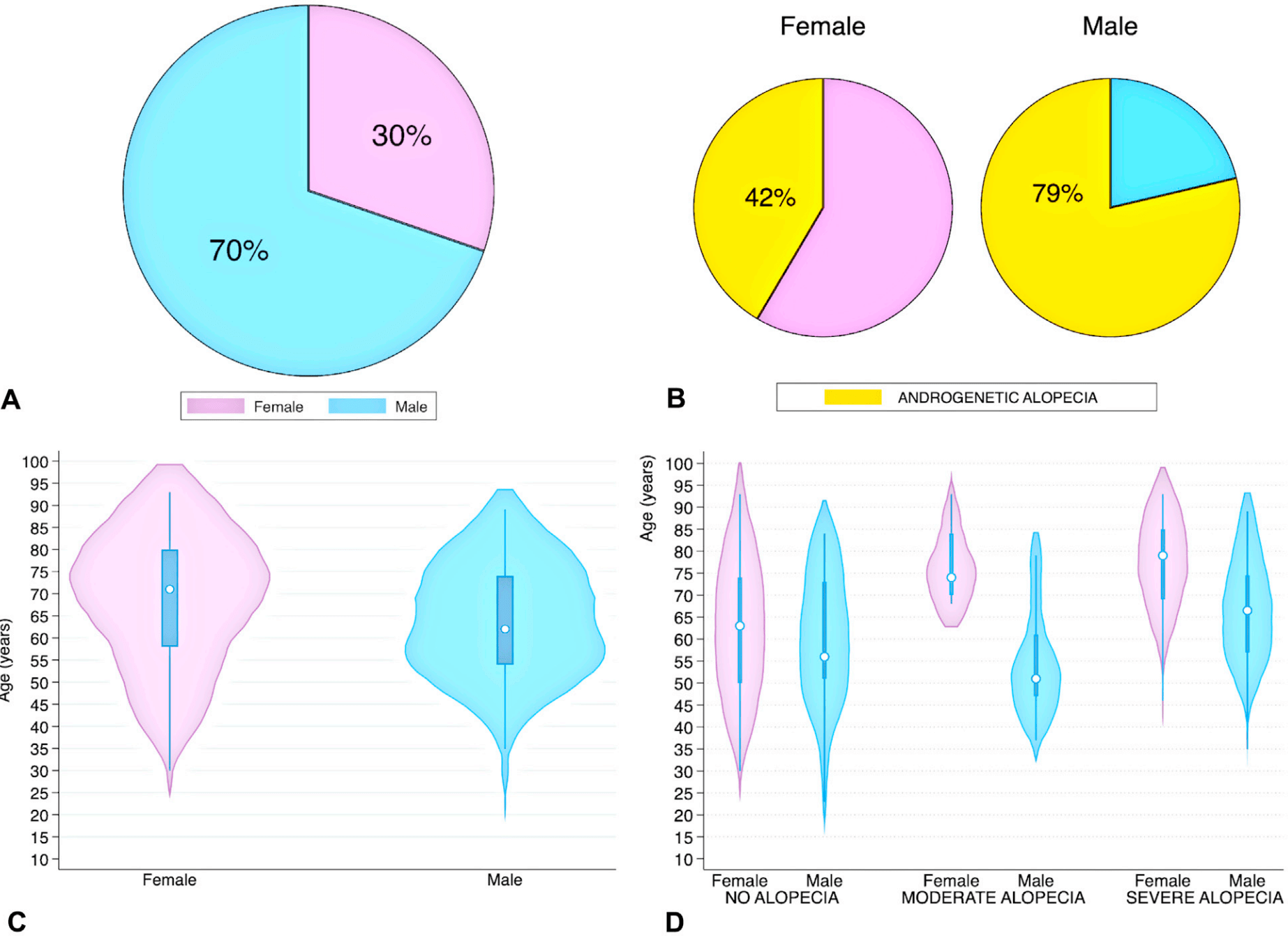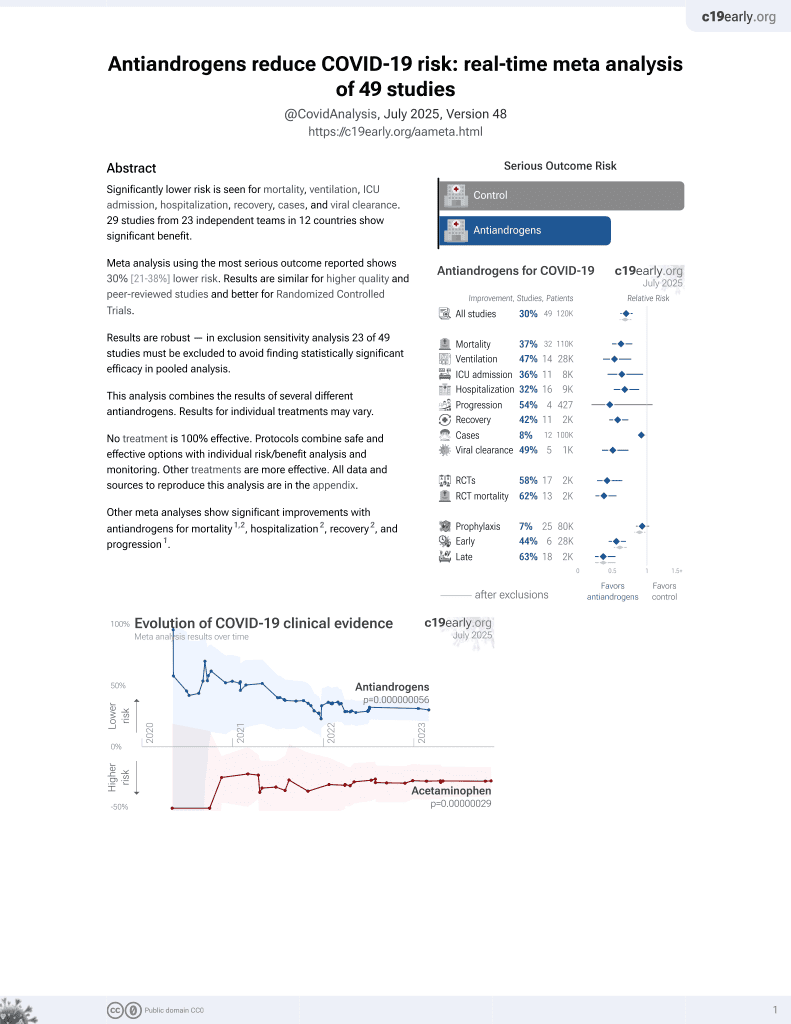
Androgenetic alopecia present in the majority of patients hospitalized with COVID-19: The “Gabrin sign”
et al., Journal of the American Academy of Dermatology, doi:10.1016/j.jaad.2020.05.079, May 2020
7th treatment shown to reduce risk in
September 2020, now with p = 0.000000056 from 49 studies.
No treatment is 100% effective. Protocols
combine treatments.
6,300+ studies for
210+ treatments. c19early.org
|
Analysis of 175 patients hospitalized with severe COVID-19, showing androgenetic alopecia (AGA) in 42% of women and 79% of men. Authors hypothesize that COVID-19 severity is androgen-mediated, and recommend study of antiandrogen treatments.
Wambier et al., 21 May 2020, peer-reviewed, 14 authors.
Abstract: 680 Research Letters
Androgenetic alopecia present in
the majority of patients hospitalized
with COVID-19: The ‘‘Gabrin sign’’
To the Editor: Dr Frank Gabrin was the first American
physician to die of severe acute respiratory syndrome coronavirus (SARS-CoV)-2 infection. Dr
Gabrin suffered from androgenetic alopecia and
was a long-term survivor of bilateral testicular cancer.1 The association between SARS-CoV-2 infectiveness and the androgen pathway has been previously
described.2
Androgen-mediated
SARS-CoV-2
J AM ACAD DERMATOL
AUGUST 2020
vulnerability may help explain the disproportioned
mortality rate among men.3 We present further
epidemiologic evidence that androgen sensitivity
might be associated with severe symptoms leading
to hospitalization due to COVID-19.
Previously, we reported a possible association
between male patients hospitalized with COVID-19
and androgenetic alopecia (AGA); however, the
study was limited by its population size of 41 men.4
In this communication, we present additional data
from patients with confirmed COVID-19 admitted
Fig 1. Epidemiologic characteristics of 175 individuals hospitalized due to severe symptoms of
COVID-19 from March 23, 2020, to April 12, 2020. A, The study population had male-to-female
ratio of 2.3:1. B, Androgenetic alopecia (AGA) was present in 42% of the women and in 79% of
the men. C, Notably, the violin plots demonstrate there was an older age distribution in the
women compared with the men. AGA severity was categorized by specific sex scales:
HamiltoneNorwood scale (HNS) for men and Ludwig scale (LS) for women into groups: ‘‘no
alopecia’’ for HNS ¼ 1 or LS ¼ 0; ‘‘moderate AGA’’ for HNS ¼ 2 or LS ¼ 1; or ‘‘severe AGA’’ for
HNS [2 or LS [1. D, Although age was widely proportional among patients with no alopecia,
moderate AGA, and severe AGA, there was a slight tendency for younger age in men with
moderate AGA and in women with no alopecia compared with the respective severe AGA
groups. The white circle represents the median, the bar in the center represents the
interquartile range, and the thin lines represent the 95% confidence interval. The wider
sections of the violin plot represent a higher probability that members of the population will
take on the given value and the thinner sections represent a lower probability.
J AM ACAD DERMATOL
VOLUME 83, NUMBER 2
Research Letters 681
Fig 2. Possible targets of the androgen pathway for severe acute respiratory syndrome
coronavirus 2 (SARS-CoV-2) prophylaxis and adjuvant therapy. Antiandrogen therapies include
gonadotropin-releasing hormone (GnRH ) analogs (degarelix, goserelin, leuprolide, leuprorelin, nafarelin), which stop luteinizing hormone (LH ) secretion and induce chemical castration.
Testosterone is regarded as the main androgen hormone, and its production is inhibited by
ketoconazole, an inhibitor of steroidogenesis. Dutasteride and finasteride, 5- -reductase
inhibitors, target synthesis of dihydrotestosterone, the most potent intrinsic androgen
hormone. Androgen receptor inhibitors may be steroidal (abiraterone, cyproterone, nomegestrol, or spironolactone), or nonsteroidal (apalutamide, bicalutamide, darolutamide,
enzalutamide, flutamide, or nilutamide). Transmembrane protease, serine 2 (TMPRSS2)
blockers include bromhexine, camostat, and nafamostat. ACE, Angiotensin converting enzyme.
due to severity criteria (mainly low peripheral
oxygen saturation) to 3 tertiary hospitals in Madrid,
Spain. The patients were randomly..
DOI record:
{
"DOI": "10.1016/j.jaad.2020.05.079",
"ISSN": [
"0190-9622"
],
"URL": "http://dx.doi.org/10.1016/j.jaad.2020.05.079",
"alternative-id": [
"S0190962220309488"
],
"assertion": [
{
"label": "This article is maintained by",
"name": "publisher",
"value": "Elsevier"
},
{
"label": "Article Title",
"name": "articletitle",
"value": "Androgenetic alopecia present in the majority of patients hospitalized with COVID-19: The “Gabrin sign”"
},
{
"label": "Journal Title",
"name": "journaltitle",
"value": "Journal of the American Academy of Dermatology"
},
{
"label": "CrossRef DOI link to publisher maintained version",
"name": "articlelink",
"value": "https://doi.org/10.1016/j.jaad.2020.05.079"
},
{
"label": "Content Type",
"name": "content_type",
"value": "article"
},
{
"label": "Copyright",
"name": "copyright",
"value": "© 2020 by the American Academy of Dermatology, Inc."
}
],
"author": [
{
"affiliation": [],
"family": "Wambier",
"given": "Carlos Gustavo",
"sequence": "first"
},
{
"affiliation": [],
"family": "Vaño-Galván",
"given": "Sergio",
"sequence": "additional"
},
{
"affiliation": [],
"family": "McCoy",
"given": "John",
"sequence": "additional"
},
{
"affiliation": [],
"family": "Gomez-Zubiaur",
"given": "Alba",
"sequence": "additional"
},
{
"affiliation": [],
"family": "Herrera",
"given": "Sabina",
"sequence": "additional"
},
{
"affiliation": [],
"family": "Hermosa-Gelbard",
"given": "Ángela",
"sequence": "additional"
},
{
"affiliation": [],
"family": "Moreno-Arrones",
"given": "Oscar M.",
"sequence": "additional"
},
{
"affiliation": [],
"family": "Jiménez-Gómez",
"given": "Natalia",
"sequence": "additional"
},
{
"affiliation": [],
"family": "González-Cantero",
"given": "Alvaro",
"sequence": "additional"
},
{
"affiliation": [],
"family": "Fonda-Pascual",
"given": "Pablo",
"sequence": "additional"
},
{
"affiliation": [],
"family": "Segurado-Miravalles",
"given": "Gonzalo",
"sequence": "additional"
},
{
"affiliation": [],
"family": "Shapiro",
"given": "Jerry",
"sequence": "additional"
},
{
"affiliation": [],
"family": "Pérez-García",
"given": "Bibiana",
"sequence": "additional"
},
{
"affiliation": [],
"family": "Goren",
"given": "Andy",
"sequence": "additional"
}
],
"container-title": "Journal of the American Academy of Dermatology",
"container-title-short": "Journal of the American Academy of Dermatology",
"content-domain": {
"crossmark-restriction": true,
"domain": [
"clinicalkey.jp",
"clinicalkey.com",
"jaad.org",
"clinicalkey.es",
"clinicalkey.fr",
"clinicalkey.com.au",
"elsevier.com",
"sciencedirect.com"
]
},
"created": {
"date-parts": [
[
2020,
5,
22
]
],
"date-time": "2020-05-22T01:31:55Z",
"timestamp": 1590111115000
},
"deposited": {
"date-parts": [
[
2020,
7,
14
]
],
"date-time": "2020-07-14T02:47:41Z",
"timestamp": 1594694861000
},
"indexed": {
"date-parts": [
[
2024,
5,
13
]
],
"date-time": "2024-05-13T17:11:38Z",
"timestamp": 1715620298595
},
"is-referenced-by-count": 122,
"issue": "2",
"issued": {
"date-parts": [
[
2020,
8
]
]
},
"journal-issue": {
"issue": "2",
"published-print": {
"date-parts": [
[
2020,
8
]
]
}
},
"language": "en",
"license": [
{
"URL": "https://www.elsevier.com/tdm/userlicense/1.0/",
"content-version": "tdm",
"delay-in-days": 0,
"start": {
"date-parts": [
[
2020,
8,
1
]
],
"date-time": "2020-08-01T00:00:00Z",
"timestamp": 1596240000000
}
}
],
"link": [
{
"URL": "https://api.elsevier.com/content/article/PII:S0190962220309488?httpAccept=text/xml",
"content-type": "text/xml",
"content-version": "vor",
"intended-application": "text-mining"
},
{
"URL": "https://api.elsevier.com/content/article/PII:S0190962220309488?httpAccept=text/plain",
"content-type": "text/plain",
"content-version": "vor",
"intended-application": "text-mining"
}
],
"member": "78",
"original-title": [],
"page": "680-682",
"prefix": "10.1016",
"published": {
"date-parts": [
[
2020,
8
]
]
},
"published-print": {
"date-parts": [
[
2020,
8
]
]
},
"publisher": "Elsevier BV",
"reference": [
{
"article-title": "Discovering the ‘heart of care’",
"author": "Gabrin",
"first-page": "20",
"journal-title": "Med Econ",
"key": "10.1016/j.jaad.2020.05.079_bib1",
"volume": "89",
"year": "2012"
},
{
"DOI": "10.1016/j.jaad.2020.04.032",
"article-title": "SARS-COV-2 infection is likely to be androgen mediated",
"author": "Wambier",
"doi-asserted-by": "crossref",
"first-page": "308",
"issue": "1",
"journal-title": "J Am Acad Dermatol.",
"key": "10.1016/j.jaad.2020.05.079_bib2",
"volume": "83",
"year": "2020"
},
{
"DOI": "10.1001/jama.2020.6775",
"article-title": "Presenting characteristics, comorbidities, and outcomes among 5700 patients hospitalized with COVID-19 in the New York City Area",
"author": "Richardson",
"doi-asserted-by": "crossref",
"first-page": "2052",
"issue": "20",
"journal-title": "JAMA",
"key": "10.1016/j.jaad.2020.05.079_bib3",
"volume": "323",
"year": "2020"
},
{
"DOI": "10.1111/jocd.13443",
"article-title": "A preliminary observation: male pattern hair loss among hospitalized COVID-19 patients in Spain—a potential clue to the role of androgens in COVID-19 severity",
"author": "Goren",
"doi-asserted-by": "crossref",
"journal-title": "J Cosmet Dermatol",
"key": "10.1016/j.jaad.2020.05.079_bib4",
"year": "2020"
},
{
"DOI": "10.1046/j.1365-2133.2001.04018.x",
"article-title": "Hair density, hair diameter and the prevalence of female pattern hair loss",
"author": "Birch",
"doi-asserted-by": "crossref",
"first-page": "297",
"issue": "2",
"journal-title": "Br J Dermatol",
"key": "10.1016/j.jaad.2020.05.079_bib5",
"volume": "144",
"year": "2001"
}
],
"reference-count": 5,
"references-count": 5,
"relation": {
"has-review": [
{
"asserted-by": "object",
"id": "10.3410/f.738205071.793575920",
"id-type": "doi"
}
]
},
"resource": {
"primary": {
"URL": "https://linkinghub.elsevier.com/retrieve/pii/S0190962220309488"
}
},
"score": 1,
"short-title": [],
"source": "Crossref",
"subject": [],
"subtitle": [],
"title": "Androgenetic alopecia present in the majority of patients hospitalized with COVID-19: The “Gabrin sign”",
"type": "journal-article",
"update-policy": "http://dx.doi.org/10.1016/elsevier_cm_policy",
"volume": "83"
}
